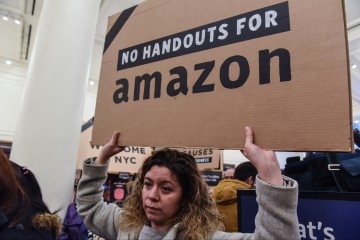- | Corporate Welfare Corporate Welfare
- | Expert Commentary Expert Commentary
- |
Maryland's $8.5 Billion Incentive Package Won't Sway Amazon. Here's Why
Maryland legislators this month approved an additional $6.5 billion in subsidies to lure Amazon’s new “HQ2” headquarters to Montgomery County. The state now holds a dubious distinction, having made the largest bid for the tech giant — at least among those that have been made public (and Montgomery County’s subsidy offer is still secret to boot).
Coupled with another $2 billion promised for infrastructure spending, the state’s offer now stands at $8.5 billion in total. That’s more than 3 percent of Maryland’s anticipated tax revenue over the next 10 years.
All things being equal, Amazon would make a great addition to Maryland’s economy. The problem is that targeted tax incentives, grants and government-backed loans in the name of “economic development” don’t actually grow the economy.
This is supported by a broad body of research. At best, targeted subsidies simply transfer money from ordinary taxpayers to large, influential corporations. And at worst, they can actually reduce economic growth by misspending public funds and pointing the economy in the wrong direction. In fact, hundreds of the top urbanists, regional economists and policymakers have signed a petition by economic theory professor Richard Florida, head of the Martin Prosperity Institute at the Rotman School of Management at the University of Toronto, calling for governments to cease offering targeted subsidies altogether.
To understand why subsidies don’t drive economic growth, think about it from Amazon’s perspective. The company is going to choose the best place for its business operations — and that might well be Maryland. But if locating in another city for geographic or other business reasons would allow Amazon to grow 1 percent faster annually, it would translate to $1 trillion in extra revenue and $17 billion in extra profits over the next 20 years. That’s double the already-mammoth subsidy that Maryland is offering.
Short of an improbable tie between two cities, the subsidies won’t make a difference in Amazon’s decision. They’re just icing on Amazon’s cake. And that means that any economic development Amazon would provide likely happens with or without them.
Even worse, if subsidies do convince Amazon to locate in the wrong city for its business model, the decrease in productivity means that national economic growth will be trillions of dollars lower than what it otherwise would have been.
More importantly, think about it from the local perspective.
Targeted corporate subsidies redirect public funds away from the public services that people depend on. They also force smaller local businesses to pay for an 800-pound gorilla to move to town and compete with them for workers, office space and public attention. Last year, for example, Wisconsin could have lowered its corporate income tax rate by 21 percent instead of providing $3 billion in subsidies to electronics manufacturer Foxconn.
Maryland could take the $8.5 billion offer to Amazon and instead reduce the corporate income tax for homegrown businesses by a whopping 96 percent, according to our calculations. Or it could reduce individual income taxes by 8.5 percent, the state sales tax by 16.5 percent, or the state property tax by 69 percent.
Instead of tax cuts, the subsidy could pay the state’s highway maintenance costs for 26 years. Or it could easily fund the $2.9 billion Red Line public transit project that Gov. Larry Hogancalled a “wasteful boondoggle” and derailed in 2015. And it should seem odd to Maryland families that the governor and legislature were able to find funds to subsidize Amazon, considering they’re struggling with how to pay for the Kirwan Commission’s recommendations to improve the state’s schools.
Adding insult to injury, Maryland would pay Amazon more than it would receive in payroll taxes from Amazon employees. The package allows Amazon to claim a tax credit amounting to 5.75 percent of an employee’s wages, provided those wages are at least $60,000. But the state tax rate for incomes below $100,000 is only 4.75 percent.
Finally, it’s worth noting that initial cost estimates for these types of subsidies are never accurate. Foxconn’s subsidy has already ballooned to $4.5 billion — a 50 percent increase in just a few months. Governor Hogan’s initial $5 billion subsidy proposal in January soared to $8.5 billion just two months later.
When someone comes to town telling you that it makes sense to spend public money to subsidize private profits, Marylanders should keep an eye on their wallets. The only winners in this game are Amazon stockholders and subsidy-granting politicians who will claim they’ve “created jobs.” Everyone else loses.
